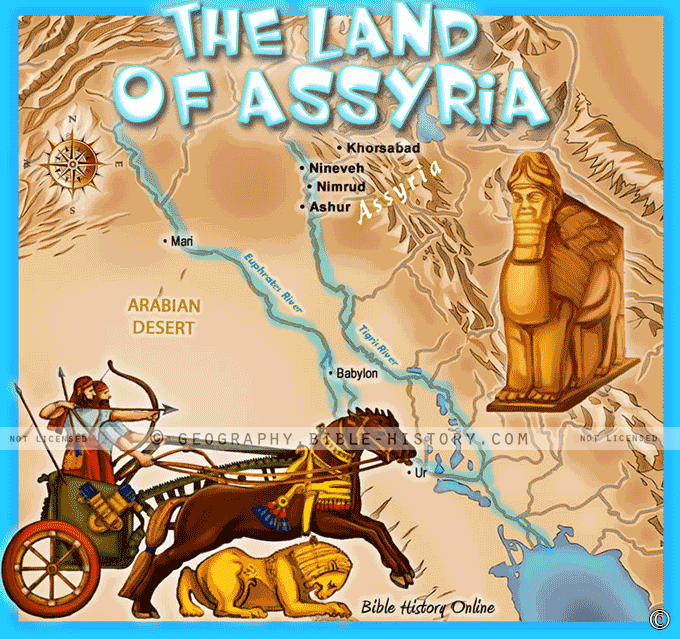
The Land of Assyria emerges as a realm steeped in historical significance, embodying the rise and fall of one of the most powerful empires of antiquity. Nestled in the region known today as northern Mesopotamia, this land witnessed the evolution of an empire that left an indelible mark on the course of human history.
Birth of an Empire
Assyria's origins can be traced back to the city-state of Assur. Over time, it expanded its influence through military prowess, strategic alliances, and shrewd governance. The Assyrian Empire, at its zenith, stretched across vast territories, uniting diverse peoples under its rule.
Military Prowess and Cultural Influence
The Assyrians are renowned for their military might, employing advanced tactics, weaponry, and siege technology. They also displayed a unique approach to governance, using a combination of centralized control and local administration to manage their vast empire.
Legacy of Ashurbanipal and Library of Nineveh
Ashurbanipal, an Assyrian king, made a profound impact by creating one of the ancient world's most famous libraries in the city of Nineveh. This repository of clay tablets preserved a wealth of knowledge, including literary works, scientific texts, and historical records.
Palaces and Architectural Marvels
Assyria's architectural achievements are evident in the grandeur of its palaces, adorned with intricate carvings and sculptures. These structures not only showcased the empire's wealth but also conveyed its cultural and religious values.
Cultural Exchange and Technological Advancements
The Land of Assyria served as a crossroads of cultures and trade routes, facilitating the exchange of ideas, goods, and technologies. This convergence influenced art, architecture, and even religious beliefs.
Decline and Legacy
The decline of the Assyrian Empire was marked by external pressures and internal strife. The empire eventually fell to the Neo-Babylonians and the Medes. However, its legacy endured through its impact on subsequent civilizations and its contributions to knowledge and civilization.
Exploring the Land Today
While the physical remnants of the Assyrian Empire are scattered and often fragmented, the legacy of this ancient civilization lives on through historical accounts, archaeological discoveries, and the enduring influence on the evolution of human societies.
The Land of Assyria is a realm where the echoes of a mighty empire resonate through time. It's a place where military prowess, cultural exchange, and architectural marvels converged to shape an era that continues to captivate modern imagination. As we journey through the Land of Assyria, we uncover the legacy of an empire that left its mark on history and the ongoing quest to understand the complex tapestry of our shared human heritage.
Blank Topo Map of The World
Abraham’s Journey
The Captivity of Judah (586-516 B.C.)
The Fall of Judah 586 B.C.
The Northern Kingdom of Israel
The Southern Kingdom of Judah
The Divided Kingdom
The Fertile Crescent
Ur of the Chaldees
Shechem in Old Testament Times
Prophets, Kings, and Nations
Jesus Last Passover
New Testament Israel
New Testament Places
Old Testament Israel
Provinces of the Roman Empire
Israel during David’s Kingdom
David’s Kingdom
Cities of the New Testament 4
Cities of the New Testament 3
Cities of the New Testament 2
Mediterranean Sea
Cities of the New Testament
First Century Jerusalem
Empire of David and Solomon
David’s Kingdom
Israel Under Rehoboam
Ophir and Tarshish
The Period of the Kings
Ramoth Gilead
Samaria
Solomon’s Temple
Zarephath and MT Carmel
Jabesh Gilead and Tribes
Judah in the Time of David
Kingdom of Saul
Kirjath Jearim
Michmash
Mount Gilboa in the Time of David
Nob Davids Flight
Shiloh
Israel and Judah
Assyrian Empire Under Esarhaddon
Assyrian Empire Under Sennacherib
Captivity of 10 Tribes
Events in 2 Kings
The Khabur River
Israel and Syria
Captives From Judah
Kingdom of Jeroboam
Mesha’s Kingdom
Pharaoh Necho Battles King Josiah at Megiddo
Babylonian, Mede and Persian Empires
Samaria and Nearby Territories
Syria at its Height
Hebron
Mahanaim
1949 Map of Israel With Boundaries
First & Second Journeys of Paul
Journeys of the Apostles
Paul’s Third Missionary Journey
Saul’s Journey to Damascus and Arabia
Paul’s Final Visits
Paul’s 1st Missionary Journey
Paul’s 2nd Missionary Journey
Paul’s 3rd Missionary Journey
Paul’s Voyage to Rome
Phillip Journeys to Samaria and Gaza
Judah at the Time of Amos
Empire of Alexander the Great
Israel Under the Maccabees
Galilee During Maccabees
Idumea Intertestamental Period
Kingdom of the Ptolemies
Kingdom of the Seleucids
Ptolemaic Egypt Seleucid Asia
The Roman World
Kingdom of Ptolemies and Seleucids
The World During the 6TH Century BC
Mount Horeb
The Red Sea
The Exodus
Ezra’s Journey to Restore Jerusalem
Israel and Judah During Hosea’s Time
The Ancient World
Canaan During the Time of Abraham
The City of Shechem
Supposed Location of the Garden of Eden
The Land of Israel in Genesis
The Jordan River
The Kingdom of Nimrod
Mount Ararat and Mesopotamia
The Descendants
Sodom and Gomorrah
The Kingdom of Egypt
The Hamites
The Kingdom of the Hittites
Ur of the Chaldees
Judah at the Time of Haggai
Jesus Passes Through Samaria
